Continuing my playing with primes, I’m now up to having 1 billion of them sitting on my hard drive. That’s 11GB in a text file. It’s actually spread out between 10 files in 100 million prime blocks to load in an out of RAM easier. They were generated in only 30 minutes using the Sieve of Eratosthenes and a modified version of the prime program found here, http://www.troubleshooters.com/codecorn/primenumbers/primenumbers.htm.
In this post I went through my files finding some statistics on special primes. The graphs below have groups of 1 million primes on the x-axis, and the number of special primes found within that 1 million on the y-axis.
Twin primes: prime numbers that differ by two. For example, 17 and 19. There are theories that there are an infinite number of twin primes, but looking at it as a limit as the function approaches infinity, it certainly looks like it goes to 0, if very slowly. In the first 1 billion primes, there are 58,047,180 twin primes (according to my program’s results at least), or about 5.8% of the total.
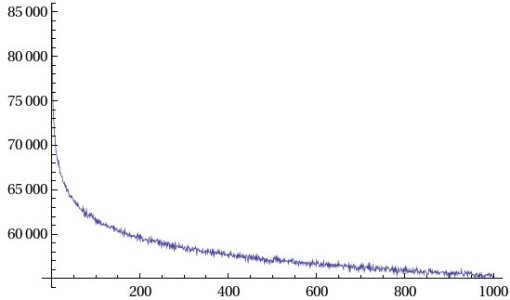 Cousin primes: prime numbers that differ by four. Interestingly, according to some number theory equations called the Hardy–Littlewood conjecture, they are supposed to have about the same distribution as twin primes. My results show it’s quite close, 58,040,262 of them in the first billion primes. The graph is about the same.
Cousin primes: prime numbers that differ by four. Interestingly, according to some number theory equations called the Hardy–Littlewood conjecture, they are supposed to have about the same distribution as twin primes. My results show it’s quite close, 58,040,262 of them in the first billion primes. The graph is about the same.
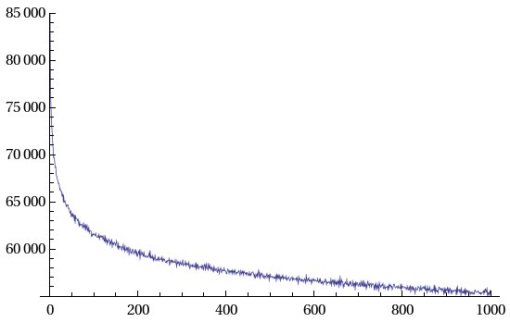 Sexy primes: no, I didn’t come up with the name, the Latin word for 6 is sex, and the math people love to name things in Latin and use Greek symbols. Primes that differ by 6. There are 105,002,853 of them in the first billion, quite a bit more than twin or cousin primes.
Sexy primes: no, I didn’t come up with the name, the Latin word for 6 is sex, and the math people love to name things in Latin and use Greek symbols. Primes that differ by 6. There are 105,002,853 of them in the first billion, quite a bit more than twin or cousin primes.
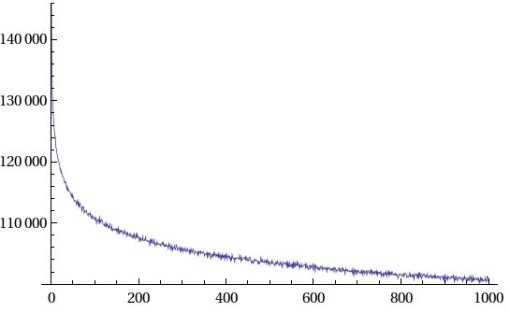 Answer primes: pairs of primes that differ by 42. Okay, I did make this one up. Any scifi fans out there will see the reference. There are 22,729,810 of them in the first billion primes. The graph is at least more interesting than the others due to the fact it’s a larger number. The distance between primes increases as the primes gets bigger.
Answer primes: pairs of primes that differ by 42. Okay, I did make this one up. Any scifi fans out there will see the reference. There are 22,729,810 of them in the first billion primes. The graph is at least more interesting than the others due to the fact it’s a larger number. The distance between primes increases as the primes gets bigger.
 Some random facts of interest (to weird people like me anyway).
Some random facts of interest (to weird people like me anyway).
The longest distance between two primes out of the first billion (consecutive composite integers): 394. There are no prime numbers between 22367084959 and 22367085353. If you split the 1 billion primes into blocks of 1 hundred million, and then find the longest runs of composite integers in each block,
292 between 1453168141 and 1453168433
336 between 3842610773 and 3842611109
354 between 4302407359 and 4302407713
340 between 8605261447 and 8605261787
382 between 10726904659 and 10726905041
354 between 11705477863 and 11705478217
346 between 14066075347 and 14066075693
376 between 16161669787 and 16161670163
372 between 20404137779 and 20404138151
394 between 22367084959 and 22367085353
Since the distance on average between primes increases as you get bigger, you’d think the max distance would increase more clearly. Such is one of the mysteries of the primes.
 Of course, primes can’t be odd numbers apart, because that would make them even. That explains the pattern a bit. Still, for something that has baffled mathematicians for centuries, it certainly does seem like there’s a pattern to it. If you draw lines between the points,
Of course, primes can’t be odd numbers apart, because that would make them even. That explains the pattern a bit. Still, for something that has baffled mathematicians for centuries, it certainly does seem like there’s a pattern to it. If you draw lines between the points, Certainly not as pretty.
Certainly not as pretty.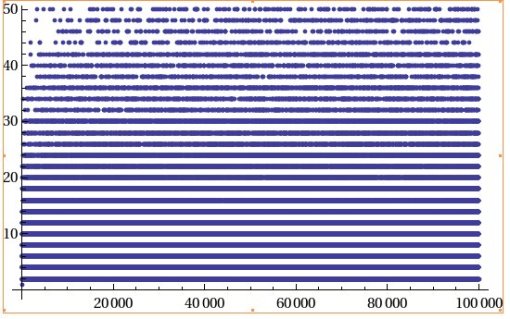 The scale makes this one a bit less interesting. Too much overlap, but Mathematica really doesn’t like big listplots like this. I even crashed it a few times when I tried to do a listplot of 100,000 data plots. 10,000 was pushing it.
The scale makes this one a bit less interesting. Too much overlap, but Mathematica really doesn’t like big listplots like this. I even crashed it a few times when I tried to do a listplot of 100,000 data plots. 10,000 was pushing it. More interesting patterns in primes, the Ulam spiral. Starting at 1 and spiraling outwords from the orgin, you create a graph like so (
More interesting patterns in primes, the Ulam spiral. Starting at 1 and spiraling outwords from the orgin, you create a graph like so ( And then remove all but the primes (
And then remove all but the primes (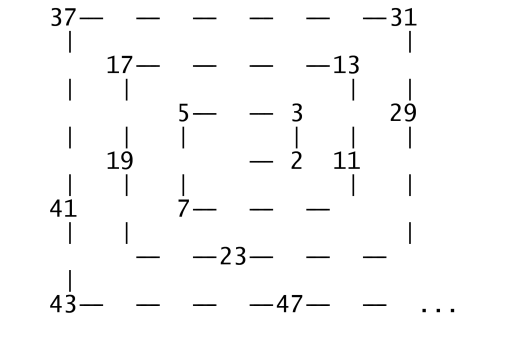 And you find an intersting pattern, that the prime numbers tend to lay along some diagnols more oftan than others. Expanding this to 150,000 primes,
And you find an intersting pattern, that the prime numbers tend to lay along some diagnols more oftan than others. Expanding this to 150,000 primes,